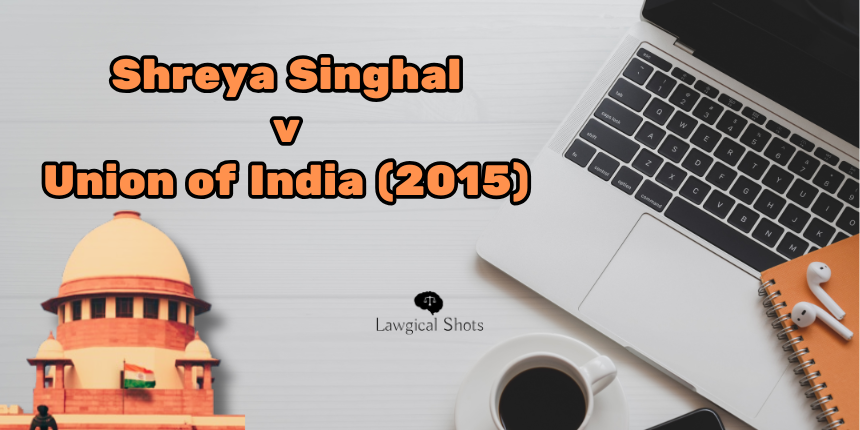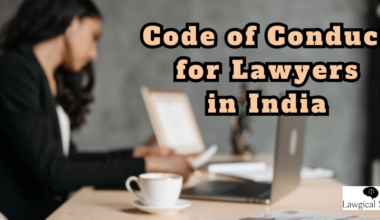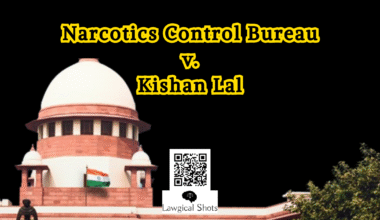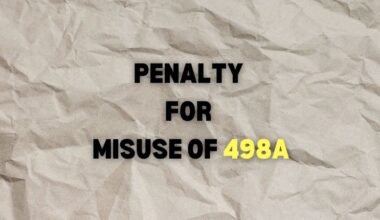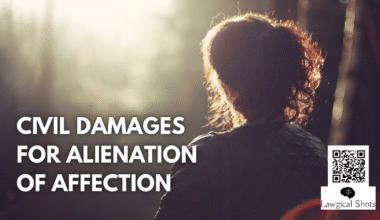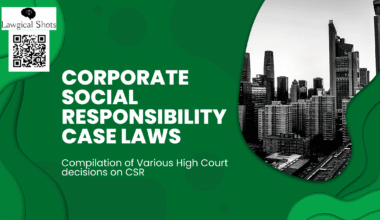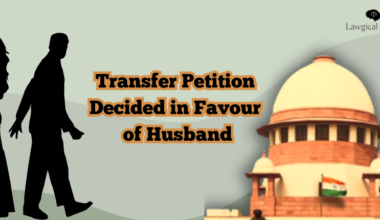This case is a tale of free speech and justice. This tale dates back to November, 2012 When the Mayanagri Mumbai came to a standstill after the demise of Indian Journalist and politician, founder of Shiv Sena, Balasaheb Thackerey. The streets were empty, looking like every place was deserted with shops shut, not out of grief, but out of fear. The two young women posted their dismay on Facebook. It was like objecting to the “bandh” that day which was stopping the routine life. Police arrested the two women on account of posting “objectionable content”. While the prosecution against the two was dropped, Advocate Shreya Singhal went on to file a writ petition against this arbitrary episode by using Section 66A of IT Act as a weapon.
Background of Shreya Singhal vs Union of India
There were several Writ petitions filed under Article 32 of the Constitution of India, 1950. The immediate cause of concern in these Writ petitions was Section 66A of the Information Technology Act, 2000. The provision was not introduced initially in the original Act. The same was added by way of an Amendment in 2009, the Information Technology (Amendment) Act, 2008.
Details of Shreya Singhal v. UoI Supreme Court Case
- Case Title: Shreya Singhal v. Union of India
- Court: Hon’ble Supreme Court of India
- SCR Citation: [2015] 5 S.C.R. 963
- Neutral Citation: 2015 INSC 257
- Year/Volume: 2015/ Volume 5
- Judgement Delivered by: Justice R.F. Nariman
- Date of decision: March 24, 2015
- Petitioner’s Name: Shreya Singhal
- Respondent: Union of India
- Case Type: Writ Petition(Criminal)/167/2012
- Case Number: WP No.: 167/2012
Issue in Shreya Singhal Case
Whether Section 66A of the Information Technology Act, 2000 is ultra vires Article 19(1)(a), Part III of the Constitution. The focus was that the offence under this Section does not fit in any of the subject matters mentioned under Article 19(2).
Petitioner’s Arguments
The petitioners contended that Section 66A was introduced on false assumptions. These assumptions were given in the Statement of Objects and Reasons for the Amendment. It says that the use of computers and the internet has given scope for new forms of crimes like publishing sexual material online, video voyeurism, breach of confidentiality, data leakage by intermediaries, Identity theft, phishing, and sending offensive messages through communication devices. So, penal provisions are required in the Act itself along with the provisions in the Indian Penal Code, 1860. Section 66A was unnecessary and instead of preventing crime, it has paved the way for suppression of free speech.
The Petitioners also raised a number of arguments concerning the constitutionality of the Section 66A. These are as follows:
1) Section 66A takes away the fundamental right of freedom of speech and expression and also it is not protected by the conditions under Article 19(2).
2) According to petitioners, annoyance, inconvenience, danger, obstruction, insult, injury, criminal intimidation, enmity, hatred, or ill-will are not covered under Article 19(2).
3) Section 66A suffers the vice of vagueness which has led to booking of innocent people. It was not clearly mentioned what amounted the offence under Section 66A and what not.
4) Articles 14, and 21 of the Constitution of India are seriously violated as there is no “intelligible differentia” between those who use the internet and those who use other mediums of communication. Punishing someone based on use of a particular communication medium is itself discriminatory.
Supreme Court’s Stand on Freedom of Speech and Expression
The Court discussed various cases both from India and the United States of America. This led to the Court to discuss “What is the content of the “freedom of speech and expression”? The Apex Court identified three concepts as follows:
1) Discussion
2) Advocacy
3) Incitement
It clarified that mere discussion or advocacy of a thought or a fact is central to the freedom of speech and expression, howsoever unpopular. But if such discussion or advocacy reaches to the level of incitement, then Article 19(2) comes into picture.
Aspects of Challenge of Section 66A of IT Act 2000
A. Article 19(1)(a)
Section 66A has covered all “information” within its reach over the internet. Let’s see Section 2(v) of the Information Technology Act, 2000. It says that “Information” includes data, message, text, images, sound, voice, codes, computer programmes, software, and databases or microfilm or computer generated micro fiche.”
The definition refers to “information” but not the content of this information. It highlights the medium of spreading this information like codes, computer programmes, software and databases. It does not differentiate among various information pieces like scientific, literary, or artistic, if this information concerns current-affairs, or it is obscene, if such information can trigger negative feelings against the Government.
Right to know is implied under Article 19(1)(a). The Court acknowledged that Section 66A is violative of right to know of people as it created offence on the basis of undefined action such as causing “inconvenience”, “obstruction”, “danger”, “insult”. It is the duty of the citizenry to keep the government informed of its actions. This information is also not an insult, it is merely a criticism that is too fair.
B. Article 19(2)
Another challenge raised by the petitioners was that the offence created by Section 66A has no relation with the subject matters mentioned in Section 19(2). In our Constitution, it is not permissible for the State to curtail freedom of speech and expression to promote the general public interest.
The Supreme Court cited Sakal Papers (P) Ltd. & Ors. v. Union of India (1962) where it was held that the State can put some restrictions on a business for public interest, but it cannot limit their freedom of speech to do so. Freedom of speech can only be restricted for specific reasons like national security, public order, or morality—not for managing any business. Each freedom under Article 19 is independent of other mentioned freedoms from 19(b) to 19(g), and the State cannot justify curbing any one of them to enhance another. A citizen is entitled to enjoy every freedom together or simultaneously. He cannot be pushed to choose one over the other.
Further, the Apex Court cited Superintendent Central Prison, Fatehpur v. Ram Manohar Lohia (1960) to understand the meaning of the expression “in the interests of”. This expression means that it must have a real and reasonable connection to common good or “public order”. This action should not be hypothetical, distant, remote which shortens the fundamental right.
C. Reasonable Restrictions
The Supreme Court cited Chintaman Rao v. State of Madhya Pradesh (1950), the expression “reasonable restriction” means a limitation based on intelligent care and deliberation.
D. Public Order
While referring to the absence of expression “public order” under restrictions to freedom of expression under Article 19(2), the Court eyed at several judgments:
In Romesh Thapar v. State of Punjab (1950) the Apex Court held that “public order” is an expression which signifies a state of tranquility which prevails amongst the members of a political society as a result of the internal regulations enforced by the Government.
Further, in Brij Bhushan and Anr. v. State of Delhi(1950) the Delhi’s Chief Commissioner issued a pre-censorship order against a magazine named “Organiser”. The Supreme Court struck down that as a restriction on freedom of press.
The Court explained that following these judgements, “public order” was added as a reasonable restriction by way of the Constitution( First Amendment) Act, 1951.
Further in Superintendent, Central Prison, Fatehpur v. Ram Manohar Lohia(1960) court found “public order” equal to public safety and tranquility. It is the absence of disorder. Public order does not discuss national upheavals but only local disturbances like protests, candle-march, riots etc.
This definition was further refined in Dr. Ram Manohar Lohia v. State of Bihar & Ors. (1966) where the Court said that it includes public order of less gravity. It relied on an analogy of three concentric circles to explain the relationship of “law and order”, “public order”, “security of state” as follows:
● The outermost circle is “law and order” which comprises all legal violations right from jumping the red light to committing murder.
● The middle circle is “public order”. Which includes riots. Such activities are bad for society but don’t threaten integrity at national level.
● The innermost circle is the “security of the state”. Which comprises terrorism, war etc.
In Arun Ghosh v. State of West Bengal (1970), the Supreme Court approved and referred to Dr. Ram Manohar Lohia’s case and added further that “Public Order is the even tempo of life of the community. Disturbance of public order is to be distinguished, from the acts directed against individuals which do not disturb the society to the extent of causing a general disturbance of public tranquility.” If a man stabs another, it does not disturb the even tempo of life. But when this stabbing was done on religious basis or caste or creed basis, it disturbs the flow of life and creates tension, and fear in the mind of the community members.
The Court also observed that this Section also does not make any difference between the mass communication and dissemination to the other person. Further, the Section does not require that such a message should have a clear tendency to disrupt public order. There is no mention of inciting anybody to do anything which a reasonable man would then say would have the tendency of being an immediate threat to public safety or tranquility under this Section. So, this Section has no proximate relationship with the “public order”.
E. Clear and Present Danger Test
Court considered the “clear and present danger test” which was for the first time propounded by the Supreme court of the USA in Schenck v. United States (1919). It is about proximity to danger. If speech is intended to result in a crime then it would result in crime like incitement, where there is a clear danger.
This was further refined in Abrams v. United States (1919) when Justice Oliver Wendell Holmes Jr. dissented and he argued that the First Amendment to the US Constitution protects the right to dissent from the government’s view points and objectives. Protection of speech should not be taken away unless there is imminent danger. He encouraged the use of “clear and present danger test”.
Hence, freedom of expression should not be taken away unless the situation created by allowing the freedom is endangering the community. So, even if Section 66A is taken from the perspective of a clear and present danger test or tendency to disrupt public order, it does not qualify for an offence.
F. Defamation
Defamation is the injury to reputation. Section 66A does not relate to defamation in its strict sense. Only thing is that the communication should be “inconvenient” or “annoying”. These two have nothing to do with defamation.
G. Incitement to an Offence
The Court clarified that Section 66A has no link to “incitement” because written words may be “advocacy”, “discussion” of a “particular point of view”. The causing of annoyance, inconvenience, danger, being grossly offensive or having a menacing character are not offences under the Indian Penal Code 1860. They are mere ingredients and not a complete offence in themselves.
The Supreme Court held that the Section suppresses freedom of speech and expression on the grounds of “grossly offensive”, “annoying”, and “inconvenient” which are not relatable to the subject matters mentioned in Article 19(2), it violates the Article 19(1) and not protected by the Article 19(2), hence, unconstitutional.
H. Decency or Morality
While referring to previously decided case concerning decency and morality, the Court cited the following cases:
In Ranjit Udeshi v. State of Maharashtra (1965) , the Court relied on “Hicklin’s Test” which says that to decide if the concerned material is “obscene”, it should be enough to corrupt anyone’s mind for immoral influences.
In Director General, Directorate General of Doordarshan v. Anand Patwardhan (2006) the Court perused the law in the United States and observed that a material may be regarded as obscene if it otherwise lacks serious literary, artistic, political, educational or scientific value and appealing to the sexual interest of the person who applies contemporary community standards.
In case of Aveek Sarkar v. State of West Bengal (2014), the Court deviated from the Hicklin’s test and resorted to “contemporary community standard” test which decides the obscenity on the basis of changing values of the community. According to it, what used to be obscene ten years ago will not be obscene now or ten years later.
I. Vagueness
The petitioners had argued that Section 66A is so vague that the accused would not understand what wrong has he done,. Also, the authorities will also be confused regarding the communication that where it falls.
The Court highlighted various decisions, but found one US Supreme Court judgment in United States v. Reese (1875) important to discuss, which has very well explained the elements of vagueness. It was stated that the Constitution (Federal) does not allow the Congress (legislature) to make a law which is wide enough to catch everyone and left open for the Court to decide the rightful conviction or acquittal.
Further, it was held that a criminal law is void for “vagueness” if it falls short of defining the criminal offence with sufficient definiteness. Ordinary people should be able to understand what conduct is prohibited and what is permitted. Also, those who administer the law must know what offence has been committed so that arbitrary and discriminatory enforcement of the law does not take place.
It means that while arrested one should understand why he has been arrested and the law enforcement can also explain why it is arresting that person. It shouldn’t say that you go to the court then the court will tell you whether you committed an offence.
The Court therefore found Section 66A excessive, arbitrary, and disproportionate.
J. Chilling Effect and Overbreadth
The Supreme Court in Shreya Singhal v. Union of India highlighted that words like “grossly offensive”, “annoyance”, and “inconvenience” were undefined terms. Even liberal views on women, casteism, etc. may be grossly offensive to any community. Advocating for reservation may be annoying to anyone who is struggling too hard for their exam. This way, any opinion may be pulled in this trap.
Section 66A is unconstitutional as it takes within its sweep protected speech and speech that is innocent in nature and is liable therefore to be used in such a way as to have a chilling effect on free speech. Chilling effect means fear of being caught after free speech. and would, therefore, have to be struck down on the ground of overbreadth, which means this law is so wide that it covers or restricts legal or genuine communication.
K. Possibility of an act being abused is not a ground to test its validity
The Court explained that the Indian Constitution does not press on impossible standards of determining validity. Mere possibility of abuse of a provision cannot be a ground to declare a provision invalid. The Supreme Court held that Section 66A must be judged on its own merits without any reference to how well it may be administered.
L. Severability
Learned Additional Solicitor General requested court towards doctrine of Severability, Article 13 of the Constitution of India. But the Hon’ble Court found this argument vague as the learned Additional Solicitor General did not point out exactly which portion of Section 66A was hit by the doctrine of severability. No part of the Section was severable, the entire Section was unconstitutional.
The Court relied on Romesh thappar v. State of Madras (1950) which cleared that restrictions must fall in Article 19(2) to the call of 19(1)(a). Words mentioned in Article 66A do not fall under eight subject matters in Article 19(2). It can be used to suppress free speech on the ground not warranted by the Constitution of India.
M. Article 14 of Indian Constitution
The petitioners raised an argument concerning Article 14’s compliance that Section 66A violates Article 14 because it creates a vague offence, leading to the arbitrary and unreasonable application of the criminal law. Further, there is no “intelligible differentia” between the medium of print, broadcast, and real live speech as opposed to speech on the internet and, therefore, new categories of criminal offences cannot be made on this ground. It treats online speech differently from other forms like print or broadcast.
They also brought to the Court’s notice that offences covered under Section 66A carry different penalties. For example, petitioners mentioned that defamation carries a penalty of two years imprisonment, a non-cognizable offence compared to similar online offences with three years imprisonment, a cognizable offence.
Finally, the Hon’ble Court rejected the argument of “intelligible differentia” under Article 14 stating that the internet is fundamentally different from other mediums—it allows anyone to reach a global audience instantly and at little cost. The “intelligible differentia” is clear – the internet gives any individual a platform that requires very little, or no payment to air someone’s views.
N. Procedural Unreasonableness
The Court said that having struck down Section 66A on substantive grounds, we need not decide the aspect of procedural unreasonableness of the Section.
O. Section 118 of the Kerala Police Act
The Supreme Court found Section 118(d) of the Kerala Police Act, 2011 violative of Article 19(1)(a) for the vague words “causing annoyance in an indecent manner” and accordingly struck it down for being unconstitutional.
P. Section 79 of the Information Technology Act, 2000 and the Information Technology (Intermediary Guidelines) Rules, 2011
Section 79 is given under Chapter XII of the Information Technology Act, 2000 which exempts intermediaries from liability if they fulfill some conditions. For example,
a) Intermediaries or online platforms are not liable for content posted by any random user. Platforms are mere communication mediums; they cannot change the content.
b) They have to follow rules prescribed by the government (compliance work).
c) They should only provide a communication system which means hosting, storing, or transmitting content.
The intermediary loses its protection if it goes beyond providing a communication system or violates any court order.
The Information Technology(Intermediary Guidelines) Rules, 2011 are those guidelines which the online platforms should follow to stay safe under Section 79 of the Information Technology Act, 2000. The Court held that “Section 79 is valid subject to Section 79(3)(b) being read down to mean that an intermediary upon receiving actual knowledge from a court order or on being notified by the appropriate government or its agency that unlawful acts relatable to Article 19(2) are going to be committed then fails to expeditiously remove or disable access to such material.”
Shreya Singhal v. Union of India (2015) Case Summary
In conclusion, it can be summarised as follows:
(a)Section 66A of the Information Technology Act, 2000 is struck down by the Hon’ble Court in its entirety being violative of Article 19(1)(a) and not saved under Article 19(2).
(b)Section 69A and the Information Technology (Procedure & Safeguards for Blocking for Access of Information by Public) Rules 2009 are constitutionally valid.
(c)Section 79 is valid but the Court said that Section 79(3)(b) should be read in a different way to mean that an intermediary (online platform) upon receiving actual knowledge from a court order asking for removal of such content or on being notified by the appropriate government or its agency that unlawful acts relatable to Article 19(2) are going to be committed, and still it fails to remove the content then it may lose the protection of Section 79 and it may be taken liable. So, such an intermediary like any social media site should remove or disable access to such material. In short, platforms are responsible for the content they receive from their users.
Similarly, the Information Technology “Intermediary Guidelines” Rules, 2011 are valid subject to Rule 3 sub-rule (4) being read down in the same manner as indicated in the judgment. It means that they don’t have to remove content, but only comply with the Court or Government order.
(d)Section 118(d) of the Kerala Police Act is struck down as being violative of Article 19(1)(a) and not saved by Article 19(2).
